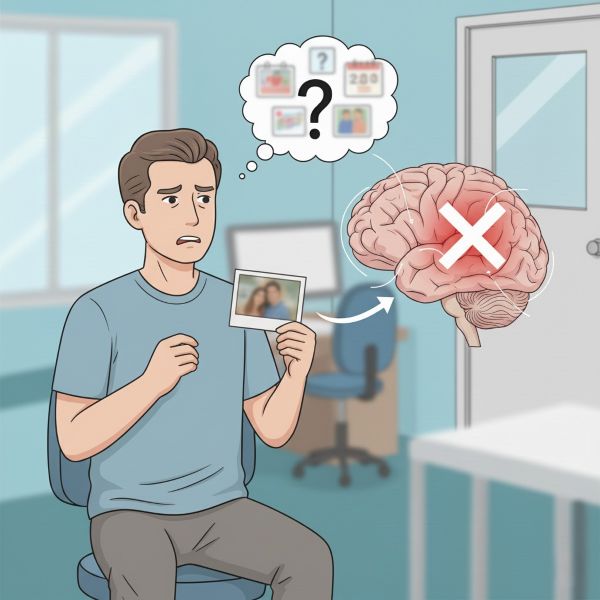Amnesia
Definition and Types of Amnesia
Amnesia is an impairment of episodic memory—the memory for personally experienced, autobiographical events. It is a component of long-term memory and is distinct from semantic memory (memory for facts) and procedural memory (memory for skills). In a pure amnesic syndrome, intelligence, attention, and procedural memory are preserved.
Amnesia can be classified as:
- Anterograde Amnesia: The inability to form new memories for events experienced after the onset of the amnesia.
- Retrograde Amnesia: The loss of memories for events that occurred before the onset of the amnesia. This often shows a temporal gradient, with distant memories being better recalled than more recent ones.
Amnesia may be acute and transient or chronic and persistent, and can occur in isolation or as part of a more widespread cognitive impairment, such as in dementia.

Amnesia results from damage to a distributed memory network, including the medial temporal lobes and the diencephalic structures of the Papez circuit.
Clinical Assessment
Various psychometric tests are used to assess episodic memory, including the Wechsler Memory Scale (WMS-R), the Recognition Memory Test (for verbal and visual memory), and the Rey Auditory Verbal Learning Test. Retrograde memory can be assessed with tools like the Autobiographical Memory Interview. Cueing can help differentiate a storage defect (true amnesia) from a retrieval deficit; if cues do not improve recall, a storage problem is likely.
Neuroanatomical Basis
The neuroanatomical substrate of episodic memory is a distributed system known as the circuit of Papez, which includes the medial temporal lobe (hippocampus, entorhinal cortex) and diencephalic structures (mammillary bodies, anterior thalamic nuclei), all interconnected. Lesions in different parts of this circuit produce different deficits:
- Medial Temporal Lobe Damage: Tends to cause severe anterograde amnesia with temporally limited retrograde amnesia.
- Diencephalic Damage (e.g., Korsakoff’s syndrome): Often causes extensive retrograde amnesia, with confabulation and diminished insight.
- Frontal Lobe Damage: May cause a "frontal amnesia," often linked to impaired retrieval and attentional mechanisms.
Causes of Amnesia
Many conditions can cause amnesia:
- Acute/Transient Causes: Closed head injury, drugs, transient global amnesia, and transient epileptic amnesia.
- Chronic/Persistent Causes: Alzheimer’s disease, sequelae of herpes simplex encephalitis, limbic encephalitis, hypoxic brain injury, bilateral temporal lobectomy, bilateral posterior cerebral artery occlusion, Korsakoff’s syndrome, and bilateral thalamic infarction.
Few chronic causes are amenable to specific treatment, though some forms of autoimmune limbic encephalitis may respond to immunotherapy.
Functional (Psychogenic) Amnesia
Functional or psychogenic amnesia may involve a failure to recall basic autobiographical details, such as one's name and address. It can sometimes show a reversed temporal gradient, with loss of older memories but preservation of recent ones.
References
Bauer RM, Grande L, Valenstein E. Amnesic disorders. In: Heilman KM, Valenstein E (eds.). Clinical neuropsychology (4th edition). Oxford: OUP, 2003: 495-573
Hodges JR, Greene JDW: Disorders of memory. In: Kennard C (ed.). Recent advances in clinical neurology 8. Edinburgh: Churchill Livingstone, 1995: 151-169
Kopelman MD. Disorders of memory. Brain 2002; 125: 2152-2190
Mega MS. Amnesia: a disorder of episodic memory. In: D’Esposito M (ed.). Neurological foundations of cognitive neuroscience. Cambridge: MIT Press, 2003: 41-66
O’Connor M, Verfaellie M, Cermak LS. Clinical differentiation of amnesic subtypes. In: Baddeley AD, Wilson BA, Watts FN (eds.). Handbook of memory disorders. Chichester: John Wiley, 1995: 53-80
Parkin AJ (ed.). Case studies in the neuropsychology of memory. Hove: Psychology Press, 1997
Pujol M, Kopelman MD. Psychogenic amnesia. Practical Neurology 2003; 3: 292-299
Cross References

